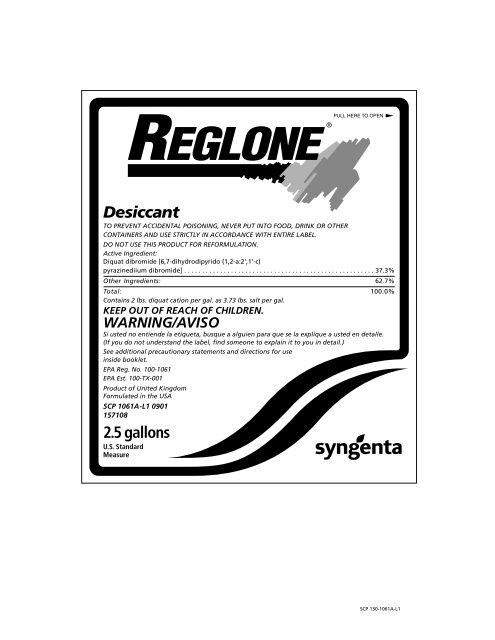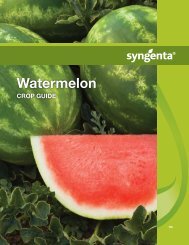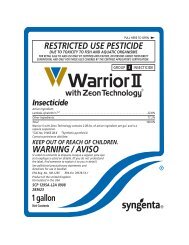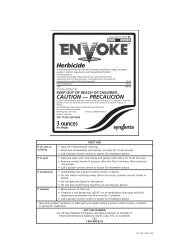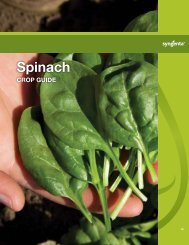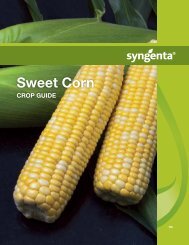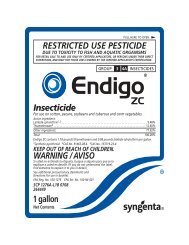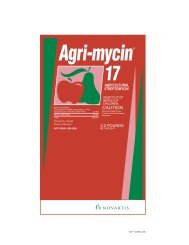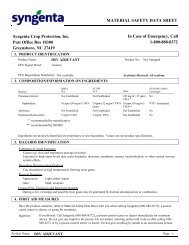Desiccant 2.5 gallons
Desiccant 2.5 gallons - Syngenta
Desiccant 2.5 gallons - Syngenta
You also want an ePaper? Increase the reach of your titles
YUMPU automatically turns print PDFs into web optimized ePapers that Google loves.
PULL HERE TO OPEN<strong>Desiccant</strong>TO PREVENT ACCIDENTAL POISONING, NEVER PUT INTO FOOD, DRINK OR OTHERCONTAINERS AND USE STRICTLY IN ACCORDANCE WITH ENTIRE LABEL.DO NOT USE THIS PRODUCT FOR REFORMULATION.Active Ingredient:Diquat dibromide [6,7-dihydrodipyrido (1,2-a:2',1'-c)pyrazinediium dibromide] . . . . . . . . . . . . . . . . . . . . . . . . . . . . . . . . . . . . . . . . . . . . . . . . . . . . . 37.3%Other Ingredients: 62.7%Total: 100.0%Contains 2 lbs. diquat cation per gal. as 3.73 lbs. salt per gal.KEEP OUT OF REACH OF CHILDREN.WARNING/AVISOSi usted no entiende la etiqueta, busque a alguien para que se la explique a usted en detalle.(If you do not understand the label, find someone to explain it to you in detail.)See additional precautionary statements and directions for useinside booklet.EPA Reg. No. 100-1061EPA Est. 100-TX-001Product of United KingdomFormulated in the USASCP 1061A-L1 0901157108<strong>2.5</strong> <strong>gallons</strong>U.S. StandardMeasureSCP 130-1061A-L1
Reglone®If swallowedIf on skin orclothingIf in eyesFIRST AID• Call a Poison Control Center or doctor immediately for treatment advice.• Immediately give water or milk to drink and induce vomiting by insertingfinger in throat.• Do not induce vomiting or give anything by mouth to an unconscious person.• Take person and product container to the nearest hospital or physician fast.• PROMPT TREATMENT IS ESSENTIAL TO COUNTERACT POISONING and shouldbe initiated before signs and symptoms of injury appear.• Take off contaminated clothing.• Rinse skin immediately with plenty of water for 15-20 minutes.• Call a Poison Control Center or doctor for treatment advice.• Hold eye open and rinse slowly and gently with water for 15-20 minutes.• Remove contact lenses, if present, after the first 5 minutes, then continuerinsing eye.• Call a Poison Control Center or doctor for treatment advice.If inhaled • Move person to fresh air.• If person is not breathing, call 911 or an ambulance, then give artificialrespiration, preferably by mouth-to-mouth, if possible.• Call a Poison Control Center or doctor for further treatment advice.NOTE TO PHYSICIANCALL SYNGENTA MEDICAL EMERGENCY ASSISTANCE 1-800-888-8372 at any hour to obtain toxicologyinformation and a diquat analysis. To be effective, treatment for diquat poisoning must beginIMMEDIATELY. Treatment consists of binding diquat in the gut with suspensions of activated charcoalor bentonite clay, administration of cathartics to enhance elimination, and removal of diquatfrom the blood by charcoal hemoperfusion or continuous hemodialysis.Have the product container or label with you when calling a poison control center or doctor, orgoing for treatment.HOT LINE NUMBERFor 24-Hour Medical Emergency Assistance (Human or Animal)or Chemical Emergency Assistance (Spill, Leak, Fire, or Accident)Call1-800-888-8372PRECAUTIONARY STATEMENTSHazards to Humans and Domestic AnimalsWARNING/AVISOMay be fatal if absorbed through skin. Harmful if swallowed or inhaled. Causes substantial, but temporary,eye injury. Causes skin irritation. Contact with irritated skin, or a cut, or repeated contact withintact skin may result in poisoning. Do not get in eyes, on skin, or on clothing. Avoid breathing vaporor spray mist. Do not feed forage from treated crops to livestock. Keep livestock and pets out oftreated fields and crop areas.Personal Protective Equipment (PPE)Applicators and other handlers must wear:• Coveralls over short-sleeved shirt and short pants.• Waterproof gloves.• Chemical-resistant footwear plus socks.• Protective eyewear.• Chemical-resistant headgear for overhead exposure.• Chemical-resistant apron when cleaning equipment, mixing, or loading.Discard clothing and other absorbent materials that have been drenched or heavily contaminatedwith this product’s concentrate. Do not reuse them. Follow manufacturer’s instructions for cleaning/maintainingPPE. If no such instructions for washables, use detergent and hot water. Keep andwash PPE separately from other laundry.When handlers use closed systems, enclosed cabs, or aircraft in a manner that meets the requirementslisted in the Worker Protection Standard (WPS) for agricultural pesticides [40 CFR 170.240(d)(4-6)], thehandler PPE requirements may be reduced or modified as specified in the WPS. Mixers, loaders, andapplicators using closed systems who meet these requirements may wear: long-sleeved shirt and longpants; protective eyewear; waterproof gloves; shoes plus socks; and a chemical-resistant apron whenmixing, loading, or cleaning equipment. If handling tasks are performed from inside an enclosed cabor aircraft with enclosed cockpits that meet these requirements may wear: long-sleeved shirt, longpants, shoes, and socks for the labeling-specified PPE. All labeling-specified PPE must be immediatelyavailable for use in an emergency. All applicable requirements as specified in 40 CFR 170.240(d)(4-6)must be followed.
Reglone®User Safety RecommendationsUsers should:• Wash hands before eating, drinking, chewing gum, using tobacco, or using the toilet.• Remove clothing immediately if pesticide gets inside. Then wash thoroughly and put onclean clothing.• Remove PPE immediately after handling this product. Wash the outside of gloves beforeremoving. As soon as possible, wash thoroughly and change into clean clothing.Environmental HazardsThis pesticide is toxic to aquatic invertebrates. For Terrestrial Uses, do not apply directly to water, orto areas where surface water is present, or to intertidal areas below the mean high water mark. Donot contaminate water when disposing of equipment wash waters.CONDITIONS OF SALE AND LIMITATION OF WARRANTY AND LIABILITYNOTICE: Read the entire Directions for Use and Conditions of Sale and Limitation of Warranty andLiability before buying or using this product. If the terms are not acceptable, return the productat once, unopened, and the purchase price will be refunded.The Directions for Use of this product should be followed carefully. It is impossible to eliminate all risksinherently associated with the use of this product. Crop injury, ineffectiveness or other unintendedconsequences may result because of such factors as manner of use or application, weather or cropconditions, presence of other materials or other influencing factors in the use of the product, whichare beyond the control of SYNGENTA CROP PROTECTION, Inc. or Seller. All such risks shall be assumedby Buyer and User, and Buyer and User agree to hold SYNGENTA and Seller harmless for any claimsrelating to such factors.SYNGENTA warrants that this product conforms to the chemical description on the label and isreasonably fit for the purposes stated in the Directions for Use, subject to the inherent risks referredto above, when used in accordance with directions under normal use conditions. This warranty doesnot extend to the use of this product contrary to label instructions, or under abnormal conditions orunder conditions not reasonably foreseeable to or beyond the control of Seller or SYNGENTA, andBuyer and User assume the risk of any such use. SYNGENTA MAKES NO WARRANTIES OF MER-CHANTABILITY OR OF FITNESS FOR A PARTICULAR PURPOSE NOR ANY OTHER EXPRESS OR IMPLIEDWARRANTY EXCEPT AS STATED ABOVE.In no event shall SYNGENTA or Seller be liable for any incidental, consequential or special damagesresulting from the use or handling of this product. THE EXCLUSIVE REMEDY OF THE USER OR BUYER,AND THE EXCLUSIVE LIABILITY OF SYNGENTA AND SELLER FOR ANY AND ALL CLAIMS, LOSSES,INJURIES OR DAMAGES (INCLUDING CLAIMS BASED ON BREACH OF WARRANTY, CONTRACT, NEGLI-GENCE, TORT, STRICT LIABILITY OR OTHERWISE) RESULTING FROM THE USE OR HANDLING OF THISPRODUCT, SHALL BE THE RETURN OF THE PURCHASE PRICE OF THE PRODUCT OR, AT THE ELECTIONOF SYNGENTA OR SELLER, THE REPLACEMENT OF THE PRODUCT.SYNGENTA and Seller offer this product, and Buyer and User accept it, subject to the foregoingConditions of Sale and Limitations of Warranty and of Liability, which may not be modified except bywritten agreement signed by a duly authorized representative of SYNGENTA.DIRECTIONS FOR USEIt is a violation of Federal law to use this product in a manner inconsistent with its labeling.Do not apply this product in a way that will contact workers or other persons, either directly orthrough drift. Only protected handlers may be in the area during application. For any requirementsspecific to your State or Tribe, consult the agency responsible for pesticide regulation.READ ENTIRE LABEL. USE STRICTLY IN ACCORDANCE WITH PRECAUTIONARY STATEMENTS ANDDIRECTIONS, AND WITH APPLICABLE STATE AND FEDERAL REGULATIONS.DO NOT APPLY THIS PRODUCT THROUGH ANY TYPE OF IRRIGATION SYSTEM.
Reglone®AGRICULTURAL USE REQUIREMENTSUse this product only in accordance with its labeling and with the Worker Protection Standard, 40CFR part 170. This Standard contains requirements for the protection of agricultural workers onfarms, forests, nurseries, and greenhouses, and handlers of agricultural pesticides. It containsrequirements for training, decontamination, notification, and emergency assistance. It alsocontains specific instructions and exceptions pertaining to the statements on this label aboutpersonal protective equipment (PPE), and restricted-entry interval. The requirements in this boxonly apply to uses of this product that are covered by the Worker Protection Standard.Do not enter or allow worker entry into treated areas during the restricted-entry interval (REI)of 24 hours.PPE required for early entry to treated areas that is permitted under the Worker ProtectionStandard and that involves contact with anything that has been treated, such as plants, soil, orwater is:• Coveralls over short-sleeved shirt and short pants• Waterproof gloves• Chemical-resistant footwear plus socks• Protective eyewear• Chemical-resistant headgear for overhead exposureNON-AGRICULTURAL USE REQUIREMENTSThe requirements in this box apply to uses of this product that are NOT within the scope of theWorker Protection Standard for agricultural pesticides (40 CFR Part 170). The WPS applies when thisproduct is used to produce agricultural plants on farms, forests, nurseries, or greenhouses.Keep all unprotected persons out of operating areas or vicinity where there may be drift.Do not allow people or pets to touch treated plants until the sprays have dried.For terrestrial uses, do not allow entry of maintenance workers into treated areas, or allow contactwith treated vegetation wet with spray, dew, or rain, without appropriate protective clothinguntil spray has dried.STORAGE AND DISPOSALProhibitionsDo not contaminate water, food, or feed by storage, disposal, or cleaning of equipment. Open dumpingis prohibited.StorageKeep pesticide in original container. Do not put concentrate or dilute into food or drink containers.Do not contaminate feed, foodstuffs, or drinking water. Do not store or transport near feed or food.Store at temperatures above 32°F. For help with any spill, leak, fire, or exposure involving thismaterial, call 1-800-888-8372.Pesticide DisposalPesticide wastes are toxic. Improper disposal of excess pesticide, spray mixture, or rinsate is a violationof Federal law. If these wastes cannot be disposed of by use according to label instructions, contactyour State Pesticide or Environmental Control Agency, or the Hazardous Waste representative at thenearest EPA regional office for guidance.Container DisposalDo not reuse container. Triple rinse (or equivalent). Then offer for recycling or reconditioning, or punctureand dispose of in a sanitary landfill, or incineration, or, if allowed by State and local authorities,by burning. If burned, stay out of smoke.CONTAINER IS NOT SAFE FOR FOOD, FEED, OR DRINKING WATER!GENERAL INFORMATIONReglone desiccant is a nonvolatile herbicide for use as a preharvest aid to desiccate certain crops inorder to facilitate harvesting. Reglone desiccant is also recommended for use as a general herbicideto control weeds in noncrop areas and nonbearing crops. Reglone desiccant is a contact-type herbicideand requires actively growing green plant tissue to function. Thorough coverage of all greenplant tissue is essential for effective control. Reglone desiccant is rapidly absorbed by green plant tissueand interacts with the phytosynthetic process to produce compounds which destroy plant cells.Herbicidal activity is usually quite rapid with effects visible in a few days.
Reglone®AGRICULTURAL USE DIRECTIONSAPPLICATIONSince Reglone desiccant is a contact-type herbicide, it is essential to obtain complete coverage of thetarget weed or crop to achieve effective results. Improper application technique and/or application tolarge, stressed, or mowed weeds will generally result in unacceptable control. Complete coverage isalso essential for effective performance in harvest aid applications. See details below for additionalinformation.Nozzle SelectionThe use of flat fan nozzles will result in the most effective application of Reglone desiccant. The useof nozzles other than flat fans may result in reduced performance due to inadequate coverage.Spray VolumeFollow recommended minimum spray volumes listed for each use of Reglone desiccant. These are minimumvolumes only, and spray volumes should be increased as necessary to obtain complete coverageof the target weed or plant without runoff from the foliage. When spraying less than 20 gals. of spraycarrier per acre, target weeds should not exceed 6 inches in height.SPRAY ADJUVANTSAlways Add One of the Following:Nonionic Surfactant (NIS)Add a NIS containing 75% or greater surface active agent at 0.06-0.5% v/v (1/2-4 pts. per 100 gals.) ofthe finished spray volume.Other AdjuvantsAdjuvants other than NIS may be used providing the product meets the following criteria:• Contains only EPA exempt ingredients.• Is compatible in mixture. Compatibility may be established through a jar test.• Is supported locally for use with Reglone desiccant through proven field trials and throughuniversity and extension recommendations.RATESFollow recommended rates listed with each use of Reglone desiccant. Use the higher label rates whenweeds are large or dense. Also, use higher labeled rates for harvest aid when crop vegetation is dense.APPLICATION TIMINGReglone desiccant should be applied to emerged weeds when they are small. Weeds 1 inch to 6inches in height are the easiest to control. When weeds have been grazed or mowed, thus removingmuch of the green foliage, allow the weeds to regrow to a height of 2-4 inches before spraying. Forproper application timing of harvest aid applications, refer to each crop for recommendations.Weeds emerging after application of Reglone desiccant will not be controlled or suppressed.RAINFASTNESSBecause Reglone desiccant is rapidly absorbed by green plant tissue, rain occurring 30 minutes afterapplication will have no effect on the activity of Reglone desiccant.ENVIRONMENTAL CONDITIONSReglone desiccant is active over a wide range of environmental conditions. Cool weather (below 55°F)will slow the activity of Reglone desiccant, as will cloudy, overcast weather, but will not affectperformance.In dry areas, dust stirred up by high winds or equipment tires can coat target surface and reduceReglone desiccant activity. Avoid applying Reglone desiccant in extremely dusty conditions.SPRAY DRIFT MANAGEMENTAVOIDING SPRAY DRIFT AT THE APPLICATION SITE IS THE RESPONSIBILITY OF THE APPLICATOR ANDTHE GROWER.The interaction of many equipment and weather related factors determine the potential for spraydrift. The applicator and the grower are responsible for considering all these factors when makingdecisions.The following drift management requirements must be followed to avoid off-target movement fromaerial applications to agricultural field crops. These requirements do not apply to forestry applications,public health uses, or to applications using dry formulations.1. The distance of the outer most nozzles on the boom must not exceed 3 /4 the length of thewingspan or rotor.2. Nozzles must always point backward parallel with the air stream and never be pointed downwardsmore than 45 degrees.Where states have more stringent regulations, they should be observed.
Reglone®Droplet SizeThe most effective way to reduce drift potential is to apply large droplets. The best drift managementstrategy is to apply the largest droplets that provide sufficient coverage and control. Applying largerdroplets reduces drift potential, but will not prevent drift if applications are made improperly, orunder unfavorable environmental conditions (See Wind, Temperature and Humidity, and TemperatureInversions).Controlling Droplet Size:• Volume – Use high flow rate nozzles to apply the highest practical spray volume. Nozzles withhigher rated flows produce larger droplets.• Pressure – Do not exceed the nozzle manufacturer’s recommended pressures. For many nozzletypes, lower pressure produces large droplets. When higher flow rates are needed, use higherflow rate nozzles instead of increasing pressure.• Number of Nozzles – Use the minimum number of nozzles that provide uniform coverage.• Nozzle Orientation – Orienting nozzles so that the spray is released parallel to the airstreamproduces larger droplets than other orientations and is the recommended practice. Significantdeflection from horizontal will reduce droplet size and increase drift potential.• Nozzle Type – Use a nozzle type that is designed for the intended application. With most nozzletypes, narrower spray angles produce larger droplets. Consider using low-drift nozzles. Solidstream nozzles oriented straight back produce the largest droplets and the lowest drift.Boom LengthFor some use patterns, reducing the effective boom length to less than 3 /4 of the wingspan or rotorlength may further reduce drift without reducing swath width.Application HeightApplications should not be made at a height greater than 10 ft. above the top of the target plantsunless a greater height is required for aircraft safety. Making applications at the lowest height that issafe reduces exposure of droplets to evaporation and wind.Swath AdjustmentWhen applications are made with a crosswind, the swath will be displaced downwind. Therefore, onthe up and downwind edges of the field, the applicator must compensate for this displacement byadjusting the path of the aircraft upwind. Swath adjustment distance should increase, with increasingdrift potential (higher wind, smaller drops, etc.).WindDrift potential is lowest between wind speeds of 2-10 mph. However, many factors, including dropletsize and equipment type determine drift potential at any given speed. Application should be avoidedbelow 2 mph due to variable wind direction and high inversion potential. Note: Local terrain caninfluence wind patterns. Every applicator should be familiar with local wind patterns and how theyaffect spray drift.Temperature and HumidityWhen making applications in low relative humidity, set up equipment to produce larger droplets tocompensate for evaporation. Droplet evaporation is most severe when conditions are both hot anddry.Temperature InversionsApplications should not occur during a temperature inversion because drift potential is high.Temperature inversions restrict vertical air mixing, which causes small suspended droplets to remainin a concentrated cloud. This cloud can move in unpredictable directions due to the light variablewinds common during inversions. Temperature inversions are characterized by increasing temperatureswith altitude and are common on nights with limited cloud cover and light to no wind. Theybegin to form as the sun sets and often continue into the morning. Their presence can be indicatedby ground fog; however, if fog is not present, inversions can also be identified by the movement ofsmoke from a ground source or an aircraft smoke generator. Smoke that layers and moves laterally ina concentrated cloud (under low wind conditions) indicates an inversion, while smoke that movesupward and rapidly dissipates indicates good vertical air mixing.Sensitive AreasThe pesticide should only be applied when the wind is blowing away from adjacent sensitive areas(e.g. residential areas, bodies of water, known habitat for threatened or endangered species, andnontarget crops).
Reglone®SPECIFIC USE DIRECTIONSThe following table indicates use pattern, rates, minimum spray volumes, and preharvest interval forspecific uses.MinimumReglone Total Spray Preharvest<strong>Desiccant</strong> Volume Per Interval Precautions, RestrictionsCrop Use Pattern Rate Per Acre Acre (Days) and CommentsAlfalfa Preharvest 1 1 /2-2 pts. (see Ground: 15 gal. 3 • On thin stands of seed(seed desiccation precautions • alfalfa use 1 pt. per acre.crop only) broadcast section for • Desiccation is complete inadditional rate Air: 5 gal. • 3-10 daysinformation)• Do not graze or feed• treated forage to livestock.• Do not use seed from• treated plants for food,• feed, or oil purposes.Clover Preharvest 1 1 /2-2 pts. Ground: 15 gal. 3 • Desiccation is complete in(seed desiccation • 3-10 days.crop only) broadcast Air: 5 gal. • Do not graze or feed• treated forage to livestock.• Do not use seed from• treated plants for food,• feed, or oil purposes.Potato Preharvest 1-2 pts. Ground: 20 gal. 7 • Do not apply to droughtdesiccation• stressed potatoes.broadcast Air: 5 gal. • Make a second application• if necessary to obtain• additional desiccation• where vine growth is• dense. For improved vine• coverage, a 5 day interval• is recommended between• applications.• Do not exceed a total of• 4 pts. per acre.Sorghum, Preharvest 1 1 /2-2 pts. Ground: 15 gal. – • Apply within 1-2 weeksGrain desiccation • of harvest and when(seed broadcast Air: 5 gal. • seeds have not morecrop only)• than 30% moisture.• Do not graze or feed• treated forage to• livestock.• Do not use seed from• treated plants for food,• feed, or oil purposes.Soybean Preharvest 1 1 /2-2 pts. Ground: 15 gal. – • Apply one week before(seed crop desiccation • harvest.only) broadcast Air: 5 gal. • Do not graze or feed• treated forage to livestock.• Do not use seed from• treated plants for food,• feed, or oil purposes.Tree, Vine, Directed spray 1 1 /2-2 pts. Ground: 15 gal. Do not use • Reglone desiccant can beSmall Fruit, for food or • used during site prepara-Vegetable feed for one • tion prior to planting andCrops – year after • up to 1 year of harvest.Nonbearing application. • Retreatment may be• necessary for completeAcerola• control of grasses and(West Indian• older established weeds.(Cherry)• Do not allow spray toAlmonds• contact green stems,Apple• foliage, or fruit as injuryApricots• can occur.Artichokes• Use a shield or wrap plantAsparagus• when spraying aroundAvocados• young trees or vines.Bananas• Do not graze treated areas.BlackberryBlueberryBoysenberryCherriesCoffeeConifersCrabapplecontinued...
Reglone®MinimumReglone Total Spray Preharvest<strong>Desiccant</strong> Volume Per Interval Precautions, RestrictionsCrop Use Pattern Rate Per Acre Acre (Days) and CommentsTree, Vine, Directed spray 1 1 /2-2 pts. Ground: 15 gal. Do not use • Reglone desiccant can beSmall Fruit, for food or • used during site prepara-Vegetable feed for one • tion prior to planting andCrops – year after • up to 1 year of harvest.Nonbearing application. • Retreatment may be(continued)• necessary for completeCranberry• control of grasses andDates• older established weeds.Dewberry• Do not allow spray toElderberry• contact green stems,Figs• foliage, or fruit as injuryFilberts• can occur.Ginseng• Use a shield or wrap plantGooseberry• when spraying aroundGrapes• young trees or vines.Grapefruit• Do not graze treated areas.GuavaHuckleberryJojobaKiwiLemonsLimesLoganberryMacadamiaMangoNectarinesOlivesOrangesPapayasPassion FruitPeachesPearsPecansPersimmonsPistachiosPlantainsPlumsPomegranatesPrunesRaspberryTangelosTangerinesWalnutsThe following table indicates use pattern and rates for noncrop or nonplanted areas.Reglone<strong>Desiccant</strong>Recommendations, Precautions,Other Uses Use Pattern Rate and RestrictionsNoncrop or Broadcast 1-2 pts. in a minimum • Apply for full coverage and thoroughNonplanted of 15 gals. water per • weed contact.Areas on Farms acre • Retreatment may be necessary to control• grasses and established weeds.Fence Lines,• Avoid spray contact with foliage of foodFarmyards, Farm• crops or ornamental plants or otherBuildings, Fuel• desirable vegetation.Storage Areas,• Add the labeled rate of 75% or greaterBarrier Strips,• nonionic surfactant to the finishedEquipment Areas,• spray volume.and Dry (non- Spot Treatment 1-2 quarts plus theflooded) Areas labeled rate of a 75%around ponds,or greater nonioniclakes, and surfactant per 100drainage ditchesgals. water or 0.75 oz.on farms(22 ml) plus thelabeled rate of a 75%or greater nonionicsurfactant per 1 gal.of water
Reglone®LIMITATIONS AND PRECAUTIONS (TERRESTRIAL USES)Direct spray contact or drift of Reglone desiccant will cause severe plant injury or death. Avoid contactof desirable vegetation.Weeds emerging after application of Reglone desiccant will not be controlled or suppressed.Retreatment may be necessary to control large weeds or established weeds.Use of dirty or muddy water for Reglone desiccant dilution may result in reduced control.Do not apply this product through any type of irrigation system.Rinse all spray equipment thoroughly with water after use.Reglone® and the Syngenta logo are trademarks of a Syngenta Group Company.©2001 SyngentaProduct of United KingdomFormulated in the USASyngenta Crop Protection, Inc.Greensboro, North Carolina 27409www.syngenta-us.comSCP 1061A-L1 0901157108For non-emergency (e.g., current product information), callSyngenta Crop Protection at 1-800-334-9481.
Reglone®<strong>Desiccant</strong>TO PREVENT ACCIDENTAL POISONING,NEVER PUT INTO FOOD, DRINK OROTHER CONTAINERS AND USE STRICTLYIN ACCORDANCE WITH ENTIRE LABEL.DO NOT USE THIS PRODUCT FORREFORMULATION.Active Ingredient:Diquat dibromide[6,7-dihydrodipyrido (1,2-a:2’,1’-c)pyrazinediium dibromide] . . . . . . . . . . . 37.3%Other Ingredients: 62.7%Total: 100.0%Contains 2 lbs. diquat cation per gallon as 3.73lbs. salt per gallonSee directions for use in attached booklet.AGRICULTURAL USE REQUIREMENTSUse this product only in accordance with itslabeling and with the Worker ProtectionStandard, 40 CFR part 170. Refer to supplementallabeling under “Agricultural UseRequirements” in the Directions for Usesection for information about this standard.EPA Reg. No. 100-1061EPA Est. 100-TX-001Product of United KingdomFormulated in the USAReglone® and the Syngenta logo are trademarksof a Syngenta Group Company©2001 SyngentaSyngenta Crop Protection, Inc.Greensboro, North Carolina 27409www.syngenta-us.comSCP 1061A-L1 0901157108<strong>2.5</strong> <strong>gallons</strong>U.S. Standard MeasureKEEP OUT OF REACH OFCHILDREN.WARNING/AVISOSi usted no entiende la etiqueta, busque a alguien para que se la explique a usted endetalle. (If you do not understand the label, find someone to explain it to you in detail.)Precautionary StatementsHazards to Humans and Domestic AnimalsMay be fatal if absorbed through skin. Harmful if swallowed or inhaled. Causes substantial,but temporary, eye injury. Causes skin irritation. Contact with irritated skin, ora cut, or repeated contact with intact skin may result in poisoning. Do not get in eyes,on skin, or on clothing. Avoid breathing vapor or spray mist. Do not feed forage fromtreated crops to livestock. Keep livestock and pets out of treated fields and crop areas.First AidIf swallowed: Call a Poison Control Center or doctor immediately for treatment advice.Immediately give water or milk to drink and induce vomiting by inserting finger inthroat. Do not induce vomiting or give anything by mouth to an unconscious person.Take person and product container to the nearest hospital or physician fast. PROMPTTREATMENT IS ESSENTIAL TO COUNTERACT POISONING and should be initiated beforesigns and symptoms of injury appear.If on skin or clothing: Take off contaminated clothing. Rinse skin immediately withplenty of water for 15-20 minutes. Call a Poison Control Center or doctor for treatmentadvice.If in eyes: Hold eye open and rinse slowly and gently with water for 15-20 minutes.Remove contact lenses, if present, after the first 5 minutes, then continue rinsing eye.Call a Poison Control Center or doctor for treatment advice.If inhaled: Move person to fresh air. If person is not breathing, call 911 or an ambulance,then give artificial respiration, preferably by mouth-to-mouth, if possible. Call aPoison Control Center or doctor for further treatment advice.NOTE TO PHYSICIAN: CALL SYNGENTA MEDICAL EMERGENCY ASSISTANCE1-800-888-8372 at any hour to obtain toxicology information and a diquat analysis.To be effective, treatment for diquat poisoning must begin IMMEDIATELY. Treatmentconsists of binding diquat in the gut with suspensions of activated charcoal or bentoniteclay, administration of cathartics to enhance elimination, and removal of diquat fromthe blood by charcoal hemoperfusion or continuous hemodialysis.Have the product container or label with you when calling a poison control center ordoctor, or going for treatment.HOT LINE NUMBER: For 24-Hour Medical Emergency Assistance (Human or Animal) orChemical Emergency Assistance (Spill, Leak, Fire, or Accident) Call 1-800-888-8372Environmental HazardsThis pesticide is toxic to aquatic invertebrates. For Terrestrial Uses, do not applydirectly to water, or to areas where surface water is present or to intertidal areas belowthe mean high water mark. Do not contaminate water when disposing of equipmentwash waters.Storage and DisposalProhibitionsDo not contaminate water, food, or feed by storage, disposal, or cleaning of equipment.Open dumping is prohibited.Container DisposalDo not reuse container. Triple rinse (or equivalent). Then offer for recycling or reconditioning,or puncture and dispose of in a sanitary landfill, or incineration.CONTAINER IS NOT SAFE FOR FOOD, FEED, OR DRINKING WATER!


